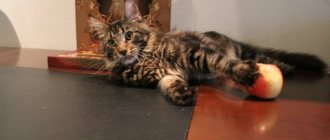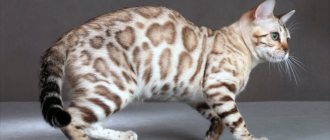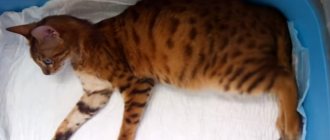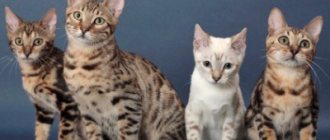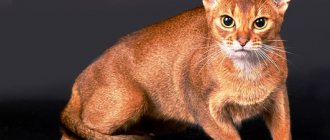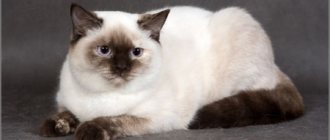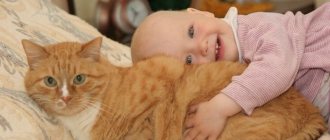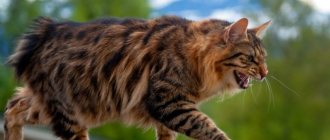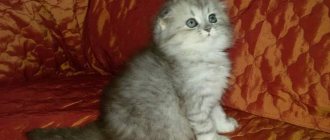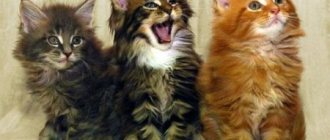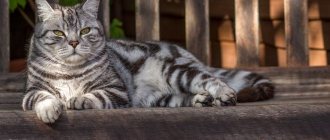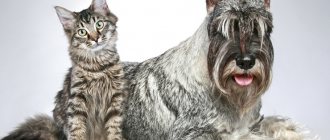Similar to a domesticated small leopard, the Bengal cat is an intelligent creature. This is a rare, expensive, animal with an unusual appearance, strikingly different from the cat fraternity. Awarded with a characteristic color with a variety of patterns, rosettes in the form of spots, arrowheads. Thanks to their active nature, with the habits of a devoted dog, such cats become favorites of owners who treat people with great income and ambitious needs.
History of the origin of the domestic Bengal breed
global $ads_google;
//data-ad-slot=”2475549904″ $ads_google = empty($ads_google) ? false : true; ?> if ($ads_google == false) {?> $ads_google = true; ?> } ?> The goal of breeding the Bengal cat, the founder of the breed, American Jane Mill, considered obtaining a domestic cat that preserved the color of its wild ancestors - this would help focus attention on the serious problem of extermination of leopard cats.
The history of the origin of the Bengal breed began almost 60 years ago, in 1961, when Jane came to Bangkok. This trip became fateful: there she received a baby Asian leopard cat, which is almost impossible to tame. The purchased baby received the name Malaysia and settled down with the new owner. The grown cat gave birth to offspring from a domestic shorthair cat, but the vicissitudes of fate did not allow her to start breeding a new breed.
A new attempt was made by Jane in 1980. She was provided with 9 hybrids of a leopard cat and domestic cats of different breeds. Then Mill fell into the hands of an Indian cat with a golden-orange color, which gave the Bengals a shiny coat called glitter.
The work was long and difficult due to many factors, and ended in success and recognition by the early 90s.
Description and standards of Bengal cats
It is impossible not to notice the external features of an exotic cat. Even when very small, the baby Bengal looks like a leopard. An adult Bengal cat receives the highest reviews and, just from one verbal description, is a true beauty.
According to the WCF standard, the breed must have a number of characteristics.
The head is a wedge with a massive chin and thickened chin pads. Thanks to this structural feature, the animal’s muzzle resembles a tiger’s mouth. This similarity is even more noticeable during yawning, meowing or growling.
The ears are short and set high on the head. They are wide at the base and their tips are rounded.
The nose is large, curved and moderately wide.
The eyes are almond-shaped and very beautiful. Eye color is clear green or golden.
The head is located on a thick and strong neck, which is in ideal proportions in relation to both the head and the body.
A cat of this breed has a large body and strong muscles.
Bengals run around the house on round, large and powerful paws. As usual, the length of the hind legs exceeds the length of the front ones.
The tail is medium in size, does not fluff, and is dense to the touch. The domestic leopard's tail has spots or rings.
Bengals are short-haired creatures with a soft, silky coat.
When interested in a description of a particular cat breed, people who are allergic to the Fel D1 protein first of all find out whether this charming creature is a hypoallergenic animal. Despite the fact that shedding almost does not affect these cats, they themselves carry the entire allergen on their skin.
global $ads_google; //data-ad-slot=”2475549904″ $ads_google = empty($ads_google) ? false : true; ?> if ($ads_google == false) {?> $ads_google = true; ?> } ?>
The breed presents a wealth of colors. A popular color is spotted-striped. This variety has shades of gray, white or red.
The most common and characteristic color of the Leopardette breed makes the cat look like a leopard.
“Sorrel” in cats finishes forming closer to the year. The coat is golden, the spots are chocolate brown, and the tip of the tail is black.
A sign of the marbled variety is spots of a peculiar, non-leopard shape.
Cats in white and gray colors are called "snow leopards". Kittens are born white, only later acquiring their characteristic color.
The colors of the Bengal breed also be called: rosette on gold, rosette on silver, marble on gold, marble on silver, seal links point, seal mink, seal sepia, charcoal, blue.
Glitter and phasing in Bengal kittens
Fazing in Bengal kittens is the process when babies from one month to four months are covered with gray or dull white fur. The name of the process comes from the English word fuzzy - unclear, uncertain. When the baby is more than a month old, the owner suddenly notices that the appearance of the young Bengal is changing. His fur becomes strewn with protruding whitish hairs, and the cat looks shaded. If phasing is severe, it makes it very difficult to see the pattern and color of the skin. The full beauty of the fur coat returns to eight months of the animal’s life.
Phasing does not manifest itself in every Bengal kitten.
The breed is characterized by glitter - a particularly strong shine to the coat. This is not a mandatory parameter for exhibitions; you can purchase a cat with or without glitter, since the standard allows both types for all representatives of the breed.
Dimensions and weight of Bengals
When buying such a pet for a home, the owner should imagine how big a Bengal cat grows. The height of an adult animal at the withers is 40-41 cm. The animal grows to this established norm by 1.5 years, but the complete completion of growth processes is completed by the age of two years.
The typical weight of purebred cats is 3.5-5.5 kg. An adult male is more massive than a female and weighs 5-8 kg. Animals of both sexes are larger and smaller than the declared weight, but this does not happen often.
If a cat seems very large and its weight is quite high, this does not mean that obesity has appeared: Bengals are nimble and energetic creatures, and, most likely, their body weight is due to the pet’s excellent physical shape and well-developed muscles.
The body length of an adult handsome leopard is about 90 cm, and the height at the withers is 40-41 cm.
global $ads_google;
//data-ad-slot=”2475549904″ $ads_google = empty($ads_google) ? false : true; ?> if ($ads_google == false) {?> $ads_google = true; ?> } ?> Table of weight of Bengal cats by month
| Age | Female | Male |
| newborn | 65-110 gr | 70-125 gr |
| 1 month | 350-500 gr | 390-560 gr |
| 2 months | 640-1100 gr | 750-1300 gr |
| 3 months | 1.2-1.6 kg | 1.3-2.2 kg |
| 4 months | 1.7-2.6 kg | 2.5-3 kg |
| 5 months | 2.5-3.1 kg | 2.8-4 kg |
| 6 months | 2.8-3.9 kg | 3.1-4.3 kg |
| 8 months | 3.2-4.8 kg | 3.7-5.1 kg |
| 10 months | 3.3-5 kg | 4.3-5.6 kg |
| 1 year | 3.4-5.2 kg | 4.8-6.3 kg |
| 2 years | 3.5-5.5kg | 5-8 kg |
What could go wrong
Hypoglycemia, hypothermia, and dehydration are common causes of early death in newborn kittens. This syndrome develops in the first three weeks, when the ability to regulate temperature is still weak and the body's carbohydrate reserves are meager. Lethargy, apathy, sometimes against the background of convulsions, may indicate incipient hypoglycemia. The problem occurs as a result of insufficient feeding. There is not enough breast milk if:
- a nursing mother produces little milk;
- there is a delay in lactation;
- the number of offspring exceeds normal.
The condition is diagnosed by a doctor who injects the kitten with a glucose solution. It is important to pay attention to the symptoms in order to immediately provide assistance to the newborn. Bottle feeding with a milk replacer will help compensate for the lack of nutrients.
Before feeding, the kitten must take its temperature. If it is below 34 degrees, you cannot feed. Hypoglycemia is often accompanied by hypothermia. The newborn is not yet capable of thermoregulation. If the cat for some reason stops keeping him warm, hypothermia will occur.
At temperatures below 34 degrees, the digestion process is disrupted, the sucking reflex is reduced, and the kitten may simply choke on milk and die. You first need to gradually warm the kitten up, and then start feeding it. Several factors can help prevent hypothermia:
- regular temperature measurements in the nest;
- observing the behavior of a cat that should be with its offspring;
- control the humidity level in the nest.
Infrared lamps are used to warm kittens. They should not hang too low to avoid another problem - overheating. The normal humidity level is considered to be 60%. If the surrounding air is too dry and the newborn does not receive enough water (about 15 ml per 100 g of weight), dehydration will occur. Loose stools can provoke this situation.
A blind kitten's skin surface area is very large compared to its mass. In a warm, dry place, moisture evaporates quickly and dehydration occurs. It is necessary to regularly check whether the kittens are sucking milk and whether access to the nipples is restricted. Severe dehydration is treated with perfusion, intravenous or intraosseous, performed by a veterinarian. Subcutaneous injections at such an early age are ineffective and sometimes cause new diseases: abscesses, osmotic dehydration, etc.
These three conditions: underfeeding, hypothermia and dehydration are interconnected, since one of them can provoke the development of other dangerous processes. The kitten should be in a warm nest with relatives and have access to mother's milk. If your pet appears weak, you should:
- measure rectal temperature;
- warm him up if it is too low;
- give the warmed kitten a drink of sweetened water;
- feed him artificial milk;
- invite a veterinarian for an examination.
These simple measures and careful attention will help save the newborn’s life and get him out. The next problem that little Bengals face is bacteriological infections. They can affect the navel (omphalitis), eyes (ophthalmia), skin (septicemia). Preventing diseases is both simple and difficult. It is necessary to ensure hygiene procedures without disturbing newborns too much.
Umbilical infections can cause peritonitis. It is necessary to regularly monitor the condition of the navel. Diagnosis and antibacterial treatment are prescribed by a veterinarian. Eye infections are hidden and begin even before the eyes open. If, when you press on the eyelid, a drop of pus flows out from under it, you should immediately show your pet to a doctor.
To remove purulent deposits, it may be necessary to artificially open the eyelids. Next, the pet is treated with eye drops. If the condition is not detected early, the kitten will suffer from eye problems for the rest of its life or will lose its vision completely.
Skin infections thrive especially in damp environments. Therefore, the bathroom is not the best place for a cat's nest. Other causes of skin lesions in newborns may include:
- infection in the mother (infection occurs during childbirth);
- unsatisfactory hygienic condition of the nest;
- little or no colostrum.
If there is no hygiene, the nest stinks, this is unacceptable. Skin infections must be treated by a veterinarian, who will determine the type of bacteria and prescribe appropriate medications. In the absence of timely assistance, microbes or their products - toxins - enter the bloodstream, which leads to serious illness and death. Signs of neonatal infection may include:
- lethargy and apathy;
- eyes water;
- pinpoint hemorrhages on the skin;
- diarrhea;
- rectal prolapse;
- purulent discharge in the corners of the eyes;
- abscesses on the skin.
Any of these signs are reason to consult your veterinarian immediately. Some breeders give pregnant cats antibiotics as a preventive measure. This is a very bad practice because kittens develop disturbances in their intestinal bacterial flora and develop strains that are resistant to antibiotic treatment. Such drugs should be prescribed to a pregnant cat by a doctor if there are appropriate indications.
If your Bengal kitten is sneezing, he probably has a cold. But respiratory tract irritation may have other causes. Their presence or absence must be confirmed by a veterinarian. In parallel with antibacterial therapy, vitamins are prescribed.
It is worth noting that Bengals inherited excellent health from their wild ancestors. If kittens are provided with proper care, they grow healthy and strong.
Characteristics of Bengal cats
The appearance of a Bengal kitten in the house expands the horizons of its owners and narrows their horizons to raising one nimble little rascal. The cat's character is bright and memorable: the combination of the natural intelligence of a predator merges with the soft playfulness and sociability of its domestic ancestors.
Reviews about domestic leopards are similar in that these cats are extremely intelligent creatures, so raising and training them is a pleasure. The family favorite remembers commands easily. It doesn't take long to train your Bengal to use the litter box.
The cat’s adaptation to new conditions occurs quickly; very soon the baby will explore all available places and begin to explore forbidden areas. You can compare the character of a Bengal with the character of dogs - he is just as ready to defend his territory, protect his owner, and carry objects from place to place. During the game, the Bengal pet will easily return the abandoned toy, since he himself is interested in spending time with the owner or his child in this way, which is why it is recommended to train the cat.
global $ads_google; //data-ad-slot=”2475549904″ $ads_google = empty($ads_google) ? false : true; ?> if ($ads_google == false) {?> $ads_google = true; ?> } ?>
Cats welcome the company of their beloved household members and are very talkative, but you should not cuddle the animals. Cats are also good with other domestic animals and can make friends with dogs. Bengal girls are well socialized, but they do not approve of communicating with strangers - they need time to understand whether a person entered the house with good intentions.
The animal picks up the mood of its owners very accurately, reacts sensitively to changes in tone of voice, and remembers the words addressed to them.
Raising a cat should start as early as possible. Bengalis are very socialized, they learn understanding and learn about the world from a person's voice. In addition, these cats, like dogs, remember words and are able to follow commands.
They regularly devote time to raising the spotted cat, mainly by playing with the young predator. The game allows the Bengal pussy to show the predatory instincts of a hunter and learn an acceptable behavioral model. Aggressive actions of a cat must be stopped, so it is important to know how to properly raise a cat.
Bengal cats definitely need physical exercise: cats' access to heights is encouraged.
Care and feeding of Bengals
A short-haired cat brings less worries at home than its long-haired counterparts, which makes caring for your pet much easier. Keeping and caring for a cat is not difficult: 2-3 times a week, devote a little time to combing the fur, which a soft rubber brush will help with. Sometimes you may not even notice the shedding, but once the procedure has begun, it is better to comb the kitty more often.
The descendant of a wild leopard cat needs to trim its claws once every couple of weeks. The ears are cleaned at the same intervals with a damp cotton pad.
It is also necessary to take care of your pet's oral cavity by brushing its teeth once a week.
The bath easily becomes a favorite place for the Bengal, who happily hits the water with his paws. Washing is allowed in rare cases using special cat shampoos.
Feeding a Bengal kitten occurs from month to month according to the feeding schedule and recommendations of specialists. Good nutrition quickly turns a small cat into a healthy, strong cat.
What to feed a Bengal kitten for 2 months
They also feed raw meat (beef or rabbit), exclude raw offal from the diet, replacing them with boiled sea fish once a week. Dairy products in the form of kefir, baby cottage cheese without any additives, and low-fat cream are useful for cats. The daily food intake also involves the addition of vegetables not exceeding a quarter of the volume of meat products. These are carrots, tomatoes, bell peppers. A Bengal cat can be switched to premium and super premium dry food, which the animals eat with benefit and pleasure.
Keeping a neutered cat involves replacing natural nutrition with specialized food.
Recommendations for creating favorable conditions for the growth and development of a kitten
- It is necessary to keep your pet in a clean, well-kept room. The owner must wash the cat's litter box on time. Once a month you need to bathe and comb your cat. Bowls should be washed every few days.
- Prevention of helminthiases should be carried out at least once every 3 months.
- If you have chronic diseases, you must visit a veterinarian for preventive examinations.
- Comprehensive vaccinations against infections must be updated every year. This reduces the risk of contracting viral and bacterial diseases. Even if the cat does not leave the apartment, the infection can be brought by the owner on the sole of the shoe.
- If cat food does not contain a vitamin-mineral complex, it must be purchased separately from a veterinary pharmacy.
- Do not expose your pet to unnecessary stress. It is better not to give reasons for jealousy and resentment. Screaming and physical impact as punishment is a direct path to pet distress.
- If possible, avoid mating your cat early. There is a risk of stunted growth and development due to hormonal imbalance. Also, a fragile organism will devote all its strength to raising offspring in the womb, exhausting the cat.
Health of the Bengal cat breed
Fortunately, thanks to breeding work and natural hereditary immunity, Bengal exotic beauties have excellent health indicators. But if their immunity resists most feline diseases, then there are some genetic diseases, the fight against which in many cases is quite successful.
global $ads_google; //data-ad-slot=”2475549904″ $ads_google = empty($ads_google) ? false : true; ?> if ($ads_google == false) {?> $ads_google = true; ?> } ?>
The most common phenomenon is “dry nose syndrome.” This problem can occur in kittens up to one year of age. You can't miss a dry nose: cracks and crusts on the surface of the nose become ulcers. In general, this condition is not critical to health and does not cause any special problems for the animal itself. To know for sure whether a dry nose promises trouble, it is better to consult a veterinarian - it happens that this condition develops into an ulcerative lesion of the nose. The doctor prescribes timely treatment that will help restore the healthy state of the nasal surface.
Bengals are sensitive to poor quality food, so to avoid loose stools, the cat is fed only selected food and always provides the pet with fresh water.
There are two serious genetic disorders: hypertrophic cardiomyopathy (HCM) and flat chest syndrome (FCK) in kittens. In the first case, observations and testing are mandatory; proper care will allow the cat to live a long and good life. The second problem is a serious obstacle to the survival of kittens and is looking for a solution. If a Bengal cat was taken from a cattery with a good reputation, where inbreeding and the use of antibiotics by the pregnant female were not allowed, the problem is unlikely to affect her and her offspring.
Miniature leopards are vaccinated according to a schedule starting at 8 weeks. All vaccinations are prescribed by a veterinarian.
The life expectancy of a healthy Bengal cat is 14-16 years if it lives under the supervision of attentive and caring owners.
If the cat was taken as a family pet, then you need to monitor the onset of puberty in order to castrate or sterilize the animal in time. The first heat in a Bengal cat occurs at 6-8 months, when the female’s weight reaches 2.5-3.3 kg. Cats “grow up” by 9 months. If you want to get offspring from your pet, you need the obligatory assistance of a specialist in breeding, otherwise even a successful mating, healthy pregnancy and problem-free childbirth do not guarantee full-fledged offspring.
How do Bengals develop?
| Days, months | Events, activities |
| 5-8 days | The ear canal opens |
| 7-12 days | Eyes open |
| 12-21 days | The first teeth appear |
| 13-16 days | Ability to navigate by sound |
| from 14 days | Vision becomes clearer |
| from 18 days | First claw trimming Ability to stand on paws |
| 21-30 days | Learn to walk ; Fang trimming and deworming if necessary |
| from 30 days | Start of complementary feeding, toilet training |
| 5-10 weeks | Routine prevention of helminths Immunity borrowed from the mother weakens |
| 6-16 week | Vaccination |
| 8-12 week | Revaccination |
| 3 months | Moving to a new home |
| 12-14 week | Permanent teeth appear, immunity decreases |
| 3.5-7 months. | Routine vaccination |
| 6 months | Puberty |
| 4-20 months | Sterilization, castration |
“Gaining excess weight is not common in Bengal kittens, but if it happens, you should contact your veterinarian.”
Buy a Bengal kitten
Nurseries where you can buy a Bengal kitten are quite common in Russia. You won’t be able to save money on buying a descendant of a wild Asian leopard cat if you want to buy a purebred animal that will strictly meet the standards. In the nursery, the buyer will learn all the information about the future cat, its pedigree, and hear interesting facts about the character of the domestic mini-leopard.
The cost of the Bengal remains high precisely because of the difficulties with breeding. The first generation of Bengals will be infertile if they are males. Females of the first generation are crossed with Bengals and a second generation is obtained, where most of the males are sterile. In the third generation from the f2 female, only some males are sterile. The fourth generation are considered true representatives of the Bengal breed, and have a full range of characteristic skills and traits.
The price for a Bengal cat in Russia is:
- pet class
25,000-50,000 rubles; - breed class
50,000-100,000 rubles; - show class from
100,000 rubles
.
What to name a Bengal kitten
When a Bengali boy or girl arrives in the house, the family may have a number of names ready. But before you give the kitten a nickname, you should know that it must begin with the same letter as the name in the passport.
global $ads_google; //data-ad-slot=”2475549904″ $ads_google = empty($ads_google) ? false : true; ?> if ($ads_google == false) {?> $ads_google = true; ?> } ?>
Also, you should not give a new cat the nickname of your previous pet, this is not only a bad omen, but also a careless attitude towards the memory of a deceased or missing pet.
A long name is difficult to pronounce and difficult for a cat to remember. Hissing sounds are welcome, to which the cat will react most quickly. You can experiment and try calling the cat by different names. There is a chance that the animal will choose its own name.
Handy tables have been created with names that might be suitable.
| Girl | Boy | ||
| Julie Dosya Cleo Dotty Shelma Ivy Eva Aida Stesha Fanta Vikki Iksa Yesya Lika Liya | Almira Brandy Toffee Yuni Tori Lynx Klepa Cher Goldie Ulfi Bara Baksa Goldie Lucky Finka | Joshua Joe Alistair Leo Easy Bingo Ike Luntik Wirt Tory Rain Ride Whiskey Martin Ralph | Vince Rick Jacques Mort Indie Byte Drake Knight Spot Fima Gore Chen Zipper Gizmo Weiss |
How to choose a pet
Where can I get a beautiful Bengal kitten? First you need to find a good nursery. The Bengal cat breed is rare and exotic, so prices for Bengal kittens are never low. You should not buy an animal with dubious pedigree and heredity for several thousand dollars. Bengal club pets have a verified biography, receive the necessary care and good upbringing. A responsible breeder provides documents for the kitten and draws up an official sales contract. This is a safe buy.
“Bengals are active and sociable kids, they are suitable for those who are ready to devote enough time to their pet.”
Prices for purebred Bengal cats start at $5,000. Are leopard kittens cheap or expensive? Depends on the class. Bengal kitten F1, girl or boy, pet, elite show class individuals intended for breeding and/or participation in exhibitions, will cost several times more. You will have to spend a lot on the items and materials needed to keep a young Bengal tiger: a tray, a house, bowls, food, medicine, litter, toys, etc.
Proper care from a good breeder from the first days of life ensures the health of the kitten. Elite kittens practically do not get sick if they are provided with appropriate conditions. Breeders lay the foundation for normal socialization and education of the Bengal. The first days in your new home will go smoothly. The new owner just has to develop useful skills.
After the cattery has been selected, they begin to select kittens on the website. If the choice is made, you can order or reserve a kitten. Many future owners come to meet a new family member, but you can only take home a pet that is three months old.
A good breeder will not give away a kitten earlier, since it is necessary to complete its upbringing, carry out the necessary vaccinations and deworming. When examining, you can pay attention to the eyes and ears. In well-groomed individuals they are clean. Information about the pedigree and characteristics of birth will help to get an idea of the possible development of events during the kitten's growth.
For example, two not too large individuals rarely produce large offspring. If there were many kittens in the litter, a slight lag in the rate of weight gain is understandable. Such pets need more attention and nutrients to compensate for underweight.
“Dim and fuzzy fur color in a three-month-old Bengal, as well as a cloudy yellow-green iris, are normal. During phasing, the kitten should look like this. The final formation of eye color and coat will occur later.”
Conclusions about the breed
The Bengal cat deservedly receives praise and admiration, but not only due to its chic external characteristics:
- The cat's character is ideal for sociable and sensitive people. Both adults and children can play with the furry baby;
- if the owner does not have time to care for the cat, then it is better to opt for a less demanding breed;
- without experience it is not worth breeding cats;
- a well-developed intellect only pleases;
- the cat does not like to be squeezed;
In general, Bengals have good health and delight with their intelligence.
Colors
A distinctive feature of Bengal cats is their unique color. Kittens are born with bright fur; by 3-4 weeks the colors fade noticeably, but by 2 months they return to their original color.
The following are officially recognized: silver tabby (gray), brown tabby, seal sepia tabby, seal mink tabby, seal lynx tabby and blue tabby. The pattern on the wool should be as clear as possible. Of the two existing ones - spotted and marbled - the first is more common.
In the photo there is a Bengal cat of popular colors: brown tabby marbled and silver tabby (gray) spotted
